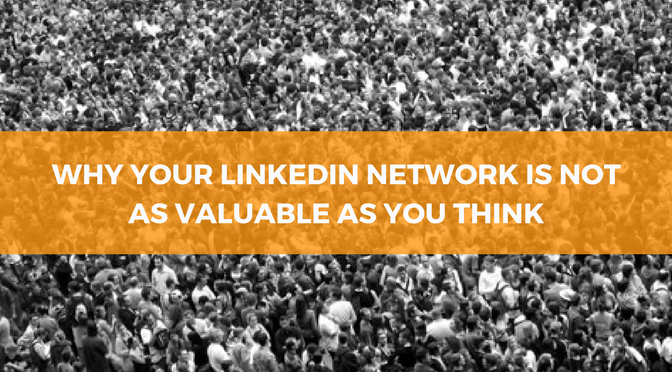Why Your LinkedIn Network Is Not as Valuable as You Think
Feeling pretty good about yourself now that you’ve gathered 500+ LinkedIn connections? Don’t. The number itself is meaningless.
Don’t get me wrong. There is great value in having a large LinkedIn network. Every time you add a connection, that person’s connections become part of your network. And each time they add a connection, that person’s connections get added to your network. Etcetera. Etcetera. Etcetera. If you like big numbers, watching your network grow can be fascinating.
Here’s how my network has grown over the last two days:
The most important thing about members of your network is that you can find each other. You’ll show up on search results for your keywords and they can access your profile. LinkedIn might even recommend they connect with you. In theory you’ll be exposing more people to your ideas, articles and discussions.
LinkedIn members who are not within your network might as well not exist. You may see their names in a search, but you won’t be able to see their profile – and vice versa. (More info here: LinkedIn Network Explanation.)
But ……
How many of these people are relevant to your business objectives? If you’re like most of our clients, you’ll be surprised at how few actually are. If you’re on LinkedIn to generate leads or a thought leadership position, you need to focus on the people that matter.
Filter your contacts list and see what you’ve really got.
One of the first exercises we ask our new clients do is to tag their connections into different groups – usually current customers, prospects, media, partners, potential partner and do not market.
Try it. I’ll bet you a free LinkedIn strategy session your “do not market” group is the biggest by far. We recently had a new client, the head of sales and marketing at an analytics company, do this with his list of 1142 connections. When the dust cleared there were 67 people on the list of connections who are relevant to this person’s sales and marketing efforts.
This is not uncommon and there are plenty of reasons it happens. In this case, the client had recently made a major career move. Another client in a similar situation has taken technology he developed in the ecommerce industry, applied it to a software application in the HR space and launched a company around it. His existing connections are heavily skewed to the ecommerce business. He needs to reach people in HR positions.
Even if you haven’t made any major career or business changes, your list of connections with current business value for you is smaller than you think.
Why is the number of relevant connections important?
We don’t put our clients through this exercise just for the hell of it. It’s an important step in the setup of any LinkedIn campaign. It accomplishes several good things:
Reality. It shows you what you’re really starting with in terms of viable business prospects with whom you’re already connected. This is the baseline for building a powerful network.
Clarity. It helps you better define the people you are trying to reach. As you go through your list you’ll find useful patterns in titles, company types and even industries.
Focus. It lets you ignore any distracting noise coming from the “do not markets” and focus on the people who will help you reach your LinkedIn objectives.
Communication. Your contacts will be nicely organized for sending messages that don’t make you sound like a dork.
Every social network has its vanity metrics, and the unfiltered number of LinkedIn connections is one of them. Don’t let that number fool you. Download your contacts, organize them into buckets, and see what you’ve really got. Then build your network with connections who will find your contributions valuable.

